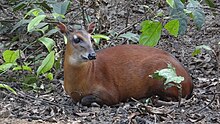Bay duiker
| Bay duiker | |
|---|---|

| |
| Individual in Gabon | |
| Scientific classification | |
| Domain: | Eukaryota |
| Kingdom: | Animalia |
| Phylum: | Chordata |
| Class: | Mammalia |
| Order: | Artiodactyla |
| Family: | Bovidae |
| Genus: | Cephalophus |
| Species: | C. dorsalis
|
| Binomial name | |
| Cephalophus dorsalis J. E. Gray, 1846
| |
| Subspecies | |
| |
The bay duiker (Cephalophus dorsalis), also known as the black-striped duiker and the black-backed duiker, is a forest-dwelling
The bay duiker is a nocturnal animal. It tends to remain solitary, but pairs can also be observed. The leopard is the main predator of this duiker. It mainly prefers fruits, but may also feed on animal matter such as bird eggs. Females may conceive by the age of 18 months. Breeding occurs throughout the year. Gestation lasts about 240 days, following which generally a single offspring is born. The lifespan of the bay duiker is typically 17 to 18 years.
The bay duiker prefers
Taxonomy and etymology
| Phylogenetic relationships of the bay duiker (Johnston et.al. 2012) |
The bay duiker was first
A 2001
Although the species may be
- C. d. dorsalis (Gray, 1846): western bay duiker, found in western Africa
- C. d. castaneus {Thomas, 1892): eastern bay duiker, found in central Africa
Description

The bay duiker is a moderately sized antelope; the typical head-and-body length is 76–103 centimetres (30–41 in).[8] Both sexes reach 44–49 centimetres (17–19 in) at the shoulder. The sexes do not vary considerably in their weights either; the typical weight range for this duiker is 18–23 kilograms (40–51 lb).[13] Hence, sexual dimorphism in this species is not as remarkable as in other bovids, though females are often larger than males.[8] The tail, black on the outside but white in the inner parts, is 9–11 centimetres (3.5–4.3 in) long.[13] The tail of the eastern bay duiker terminates in a white tuft.[8] Both sexes possess a pair of spiky horns, measuring 5–8 centimetres (2.0–3.1 in). Rowland Ward, however, recorded a maximum horn length of 12.3 centimetres (4.8 in) from Yokadouma (Cameroon).[13] The horns of females are generally narrower.[8]
Both sexes have a bright reddish-brown
The bay duiker is similar to several other duikers. The
Ecology and behavior

The bay duiker is a nocturnal animal, and consequently little is known of its behavioral patterns. During the day, the bay duiker rests against trees or in thickets. It tends to remain solitary, but pairs can also be observed. The bay duiker exhibits remarkable alertness. It depends heavily on its sense of smell for foraging and detecting potential danger. Individuals communicate through preorbital gland secretions and excrement. The leopard is the main predator of this duiker.[8][13] Eagles,[7] bonobos and mandrills[16] may also prey on the bay duiker. An alarmed individual becomes motionless, and might leap to flee.[8]
Diet
The bay duiker mainly prefers fruits. It feeds on the large fruits of
Reproduction
Females may conceive by the age of eighteen months. Breeding occurs throughout the year, and no clear peaks are known.
Gestation lasts for about 240 days, following which generally a single offspring is born. The infant weighs nearly 1,600–1,690 grams (56–60 oz), and its coat is dark reddish-brown. The brighter reddish-brown to chestnut color develops by five to six months. For the first few weeks after its birth, the infant is kept concealed in dense vegetation when the mother is away. The offspring can start taking solid food within a few weeks. Weaning occurs at around three-and-a-half months. The lifespan of the bay duiker averages 17 to 18 years.[8][13]
Habitat and distribution
The bay duiker prefers
Threats and conservation

The bay duiker has been historically
The habitat of the bay duiker has depleted to a large extent due to deforestation.
References
- ^ . Retrieved 13 November 2021.
- ^ "Appendices | CITES". cites.org. Retrieved 2022-01-14.
- ^ OCLC 62265494.
- ^ "Cephalophus". Merriam-Webster.com Dictionary. Retrieved 11 February 2016.
- ^ "dorsalis". Cambridge Dictionaries Online. Cambridge University Press. Retrieved 11 February 2016.
- ^ "Duiker". Merriam-Webster.com Dictionary. Retrieved 17 February 2016.
- ^ a b c "Duiker". African Wildlife Foundation. Retrieved 7 March 2016.
- ^ ISBN 9780691167176.
- PMID 11527467.
- PMID 22823504.
- ^ "Cephalophus dorsalis". Integrated Taxonomic Information System. Retrieved 11 February 2016.
- ^ Cotterill, F.P.D. (2003). "Ecology and conservation of small antelope: proceedings of an international symposium on duiker and dwarf antelope in Africa": 59–118.
{{cite journal}}: Cite journal requires|journal=(help) - ^ ISBN 9781408122570.
- ^ ISBN 2-8317-0016-7.
- ISBN 9789004236301.
- S2CID 20928597.
- S2CID 85044303.
- ISBN 9780761472667.
- S2CID 84815512.
- .
External links
 Data related to Cephalophus dorsalis at Wikispecies
Data related to Cephalophus dorsalis at Wikispecies Media related to Cephalophus dorsalis at Wikimedia Commons
Media related to Cephalophus dorsalis at Wikimedia Commons

